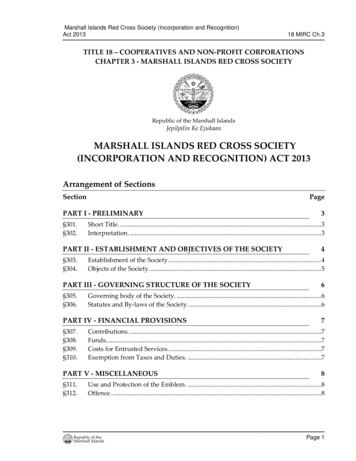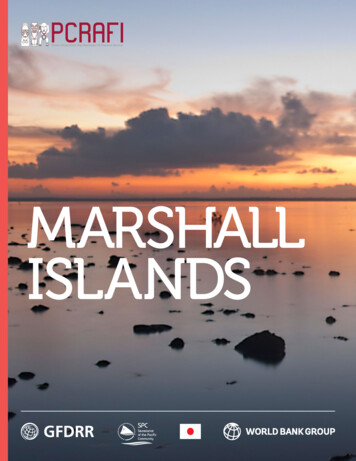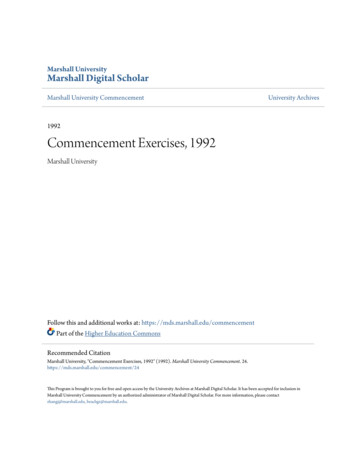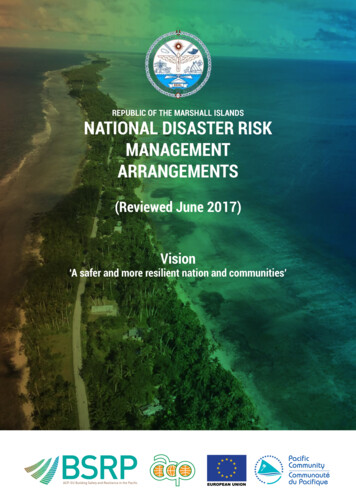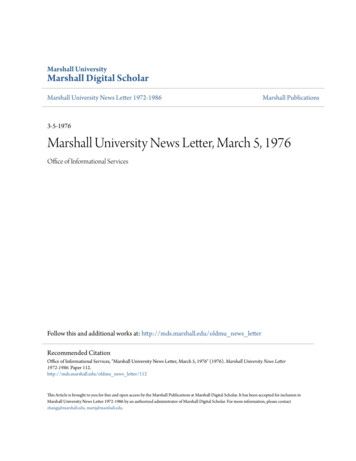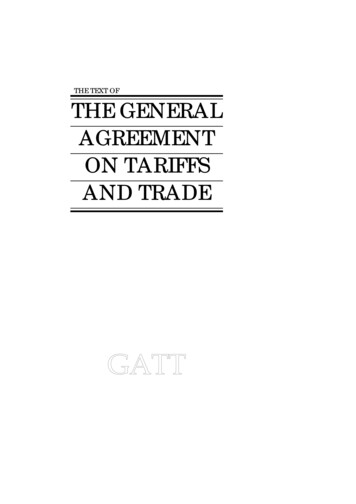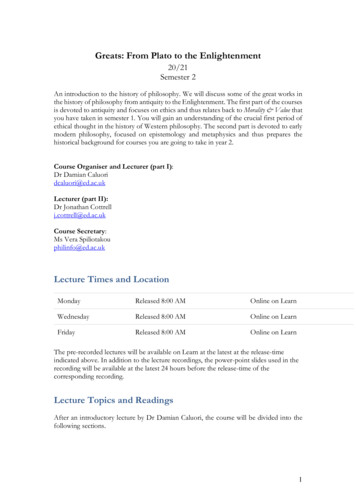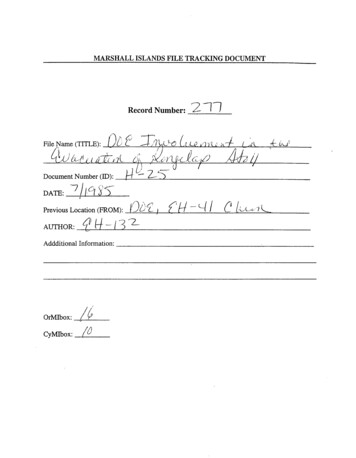
Transcription
REPUBLIC OF THE MARSHALL ISLANDSCOUNTRY PREPAREDNESSPACKAGE
The Chief Secretary’s Office andNational Disaster Management OfficeGovernment of the Marshall IslandsMajuro, Republic of the Marshall IslandsPacificHumanitarianTeamPacific Humanitarian TeamOffice for the Pacific IslandsLevel 6, Kadavu HouseFor general enquiries:UN Office for the Coordination ofHumanitarian Affairs (OCHA) asSecretariat of the PHTPhone: 679 999 166Email: pht@ochapacific.org orochapacific@un.orREPUBLIC OF THEMARSHALL ISLANDSCOUNTRY PREPAREDNESSPACKAGEFirst Published July 2017All graphs and data correct as at July2017 Goverment of RMI and PHTFRONT Cover image credit: UNDPAcknowledgementsAppreciation is extended to all that contributed their knowledge and support.Special thanks go to the Chief Secretary’s Office and National DisasterManagement Office, National Cluster System and Ministries, as well as nationaland international humanitarian and development partners. Gratitude also goesto those international entities leading the RMI CPP, in particular, the UnitedNations Development Programme through its Disaster Resilience for PacificSIDSs (RESPAC) project, the United Nations Population Fund and the Office forthe Coordination of Humanitarian Affairs.PHT partners:-Food and Agriculture OrganizationInternational Organization for MigrationInternational Federation of Red Cross and Red Crescent SocietiesOXFAMSave the ChildrenThe Office of the United Nations High Commissioner for Human RightsThe United Nations Entity for Gender Equality and the Empowerment ofWomenThe United Nations Children’s FundThe United Nations Development ProgrammeThe United Nations Office for the Coordination of Humanitarian AffairsThe United Nations Population FundWorld Food ProgrammeWorld Health Organization
W HAT IS THE COUNTRYPREPAREDNESS PACKAGE?The Country Preparedness Package (CPP) is a jointinitiative of the Government of the Republic of theMarshall Islands (RMI) and the Pacific HumanitarianTeam (PHT). The CPP is intended to strengthen thepreparedness and collaboration between nationaland international actors in disaster response.The completed CPP is a set of documents outliningthe existing national structures and the agreedplans for utilizing international support in a disasterresponse. These documents are available online andinclude links to national reference documents.About this documentThe CPP is developed and agreed with the nationalgovernment before a disaster. Through the process,national actors become more aware of internationaltools and services and how they can be activated.This will enable a more ‘demand-driven’ responsetailored to the specific context.The CPP also helps the international actors tobecome more aware of the existing national systemsand structures by clearly documenting and makingkey information available to all. This will help ensurethat responses are nationally-led with internationalactors supporting and working through the existingnational structures.This document comprises 31 sections covering arange of topics and issues relevant to internationalsupport to nationally-led disaster responses. The useof thematic sections makes it easy to find specificinformation quickly. It also allows the updating ofinformation to be straightforwardly divided amongmultiple partners.REPUBLIC OF THE MARSHALL ISLANDS The Country Preparedness Package3
PHOTO CREDIT: UNDPEach section includes the three following components:4NATIONALARRANGEMENTSA brief summary of the current status and arrangements within the country relatedto that topic, including links to key national reference documents (e.g. Terms ofReference (ToRs) or Standard Operating Procedures (SOPs) or websites) and thenames and contact details of key national structures or focal points.SUPPORTARRANGEMENTSAn outline of how the Pacific Humanitarian Team (PHT) and internationalcommunity will provide support to the national authorities in the event of adisaster, in relation to the thematic area. This section is expected to be as specificas possible and agreed with the government and other national actors in advance.This section may also note areas of disaster preparedness and response whereRMI seeks development support.REFERENCEINFORMATIONReference Information providing links to international guidance relevantdocuments and two or three basic standards (or minimum requirements) thatcountries in the Pacific should aim towards.REPUBLIC OF THE MARSHALL ISLANDS The Country Preparedness Package
TABLE OF CONTENTSACRONYMS61.RISK MONITORING MECHANISM72.LEGISLATION93.DISASTER STRUCTURES, PLANS, POLICIES AND SOPS104.ENGAGEMENT OF PRIME MINISTER / SENIOR POLITICAL FIGURES155.ENGAGEMENT OF MINISTRIES (INC PLANNING AND FINANCE)166.AWARENESS OF INTERNATIONAL HUMANITARIAN SYSTEMS & PRINCIPLES177.GENDER AND PROTECTION MAINSTREAMING188.PLAN / MECHANISMS FOR SLOW ONSET DISASTERS209.NATIONAL LEVEL PARTNER COORDINATION MECHANISM (EG CLUSTERS)2110.SUB-NATIONAL LEVEL PARTNER COORDINATION MECHANISMS2311.NGO COORDINATION/ ENGAGEMENT MECHANISM2412.CIVIL-MILITARY COORDINATION ARRANGEMENTS2513.PRIVATE SECTOR ENGAGEMENT & COORDINATION2614.PARTNER PRESENCE AND CAPACITY MAPPING2715.ASSESSMENT PROTOCOLS / MECHANISMS2916.INFORMATION MANAGEMENT SYSTEMS (INC DATA PREPAREDNESS)3017.RESPONSE MONITORING MECHANISMS3118.PUBLIC INFORMATION MECHANISMS (INC COMMUNICATING WITH COMMUNITIES)3219.EMERGENCY FUNDING MECHANISMS (INC FUNDS & SYSTEMS)3320.LOGISTICS CAPACITY, PLANNING & INFRASTRUCTURE3521.EMERGENCY TELECOMMUNICATIONS3722.STANDARD RELIEF ASSISTANCE PACKAGE PLANNING3923.HEALTH & NUTRITION4024.EDUCATION4225.WASH4426.FOOD SECURITY & LIVELIHOODS4627.PROTECTION4728.SHELTER4829.EARLY RECOVERY5030.DISASTER OR SIMULATION IN PAST 18 MONTHS5131.SPECIFIC CONTINGENCY PLAN52ANNEX 1 STRUCTURE FOR DRM IN RMI53REPUBLIC OF THE MARSHALL ISLANDS The Country Preparedness Package5
ACRONYMS6AMIAir Marshall IslandsMoNRCMinistry of Natural Resources andCommerceBSRPBuilding Safety and Resilience in the PacificCCGCentral Control GroupMoWIUMinistry of Works, Infrastructure and UtilitiesCDCCentre for Disease ControlMWSCMajuro Water Service CompanyCMACCoastal Management Advisory CommitteeNDCNational Disaster CommitteeCMICollege of the Marshall IslandsNDMONational Disaster Management OfficeCOFACompact of Free AssociationNOAACOSSPacClimate and Oceans Support Program inthe PacificNational Oceanic and AtmosphericAdministrationNTANational Telecommunication AuthorityCSOChief Secretary’s OfficePDAPreliminary Damage AssessmentDRMDisaster Risk ManagementPCRAFDRRDisaster Risk ReductionPacific Catastrophe Risk Assessment andFinancing InitiativeENSOEl Nino Southern Oscillation PhenomenonPDNAPost Disaster Needs AssessmentEOCEmergency Operations CentrePIFSPacific Islands Forum SecretariatEHAEssentials of Humanitarian AssistancePRELPacific Resources for Education & LearningEPAEnvironmental Protection AgencyPREPPacific Resilience ProjectIDAInitial Damage AssessmentPREPAREIOM-USAID funded Disaster Preparednessfor an Effective Response projectIDRLInternational Disaster Response LawPSSPublic School SystemIFRCInternational Federation of the Red Crossand Red CrescentRCSRed Cross SocietyIOMInternational Organization for MigrationRESPACDisaster Resilience for Pacific SIDS ProjectJICAJapan International Cooperation AgencyROReverse osmosis (desalination)JPOUN Joint Presence OfficeSPCPacific CommunityMALGOVMajuro Atoll Local GovernmentSOPsStandard Operating ProceduresMIMAMarshall Islands Mayors AssociationSPREPSecretariat of the Pacific RegionalEnvironment ProgrammeMIRCSMarshall Islands Red Cross SocietyTWSTsunami Warning CentreMISCMarshall Islands Shipping CorporationToRsTerms of ReferenceMDGsMillennium Development GoalsWSOMarshall Islands Weather Service OfficeMISCMarshall Islands Shipping CompanyWASHWater and SanitationMoFAMinistry of Foreign AffairsWMOWorld Meteorological organizationMOFMinistry of FinanceWUTMIWomen United Together in Marshall IslandsMOT&CMinistry of Transportation & CommunicationUSAIDMoHMinistry of HealthUnited States Agency for InternationalDevelopmentMoCIAMinistry of Culture and Internal AffairsREPUBLIC OF THE MARSHALL ISLANDS The Country Preparedness Package
1.RISK MONITORING MECHANISM Current StatusThe Republic of the Marshall Islands (RMI) isextremely vulnerable to the effects of naturaldisasters. The major natural hazards in RMI aretropical storms, typhoons, storm surge and drought.Additional challenges include marine pollution,ecosystem degradation, coastal erosion and foodinsecurity. Rising sea level is the biggest threat in RMIas its highest point is just 10 meters above sea level.Climate change is also expected to exacerbate thecountry’s vulnerability to natural hazards.Risk monitoring is principally delivered through theMarshall Islands Weather Service Office (WSO),which advises the Chief Secretary’s Office (CSO). Ata technical level the WSO also reports the NationalOceanic and Atmospheric Administration (NOAA)’sPacific ENSO Applications Climate Centre (PEAC)on a quarterly basis. WSO is a member of the Water,Sanitation and Hygiene (WASH) Cluster.In addition to data interpretation and response fromscientific agencies, WSO works with the NDMO to: SystemsOnce the WSO advises a threat to RMI, the CSOmay activate the NDC (see Section 3).PartnersThe WSO is tasked with providing weather forecasts,early warnings on hazardous weather and otherweather-related products to the government forthe purposes of protection, safety and generalinformation. This is done through the following: Delivery of scientific assessment and analyticalservices;Undertaking of manual surface aviation, synopticand upper-air observations, transmitting data tothe Global Telecommunication System/IntegratedWorld Meteorogical Organization (WMO)Information System;Receipt of data from outer island focal points(mayors, disaster committees, etc) usingstandardized drought monitoring forms;Receipt and interpretation of daily data frompartner scientific agencies (especially NOAA) onhazards to generate adaptive weather forecastsand warnings for local constituents;Advice to the National Disaster ManagementOffice (NDMO) and Chief Secretary on keythreats to inform and for consideration of furtheraction (e.g. activation of the National DisasterCommittee (NDC) or other actions);Designate focal points (particularly the mayors)to receive information on the state of weather onthe outer islands;Share warnings and alerts.Information exchange with outer island focal pointsis most commonly achieved though High Frequency(HF) radio and the Chatty Beetle. The WSO:Communication of alerts and warnings to RMIauthorities and communities, including advisingprecautionary action that could be taken. Under the Compact of Free AssociationAgreement (COFA), an agreement between RMIand the United States of America (USA) signed in1986, (see reference) the United States Agencyfor International Development (USAID) and theUS Federal Emergency Management Agency(FEMA) play an important role during disastersand provide, at no cost to RMI, services includingair safety, weather forecast, health services andassistance in the event of natural disasters.The weather forecast is provided by the NationalOceanic and Atmospheric Administration of theUnited States (NOAA). NOAA provides:–– Critical daily data on natural(hydrometeorology and seismic) hazardsthreatening RMI. This includes both thePacific Region Headquarters in Honolulu,Hawaii as well as the NOAA Guam Office(RMI Meteorological Services use differentdata according to where the hazardsoriginate). These offices provide technicalsupport to the weather services of allMicronesian Offices in cooperation withthe Republic of Palau, Federated States ofMicronesia (FSM) and RMI, in accordancewith the provision of the COFA between theUS and each Micronesian government;REPUBLIC OF THE MARSHALL ISLANDS The Country Preparedness Package7
–– Training in meteorological services;–– As part of monitoring and trend development,WSO also sends rainfall and temperaturedata to National Weather Service ForecastOffice Guam to keep them briefed. NOAA’s PEAC and the Guam Forecast Officeprovide long and short term rainfall outlooks andforecast.The Richard H. Hagemeyer Pacific TsunamiWarning Centre (PTWC), located on Ford Island(Oahu, Hawaii), serves as the operational centreof the Tsunami Warning System (TWS) in thePacific. The TWS detects and locates majorearthquakes in the Pacific Basin to determinetsunami generation and provide timely andeffective tsunami information and warnings to thepopulation of the Pacific.The University of Guam, together with NOAA,holds a monthly conference with the WSO todetermine national disaster trends and threats.Through their projects and focal points on theouter islands, the International Organization forMigration (IOM) and the International Federationof the Red Cross and Red Crescent (IFRC)provide rainfall data validation etc. via the WASHcluster. They also provide some capacity buildingfor outer island observers:The Marshall Islands Red Cross Society(MIRCS) works with WSO to monitor weatherinformation and tidal schedules to preparefor extreme or potentially damaging events.MIRCS, in cooperation with WSO and theNDMO, conducted a pilot Community BasedEarly Warning System project in Jenrok (2015to 2016 FINPAC-IFRC/SPREP) to enable thecommunity to better prepare for and respond inthe event of a disaster.Pacific Community (SPC) in the provision of technicalsupport in particular: Climate and Oceans Support Program in thePacific (COSSPac) sea level and temperaturemonitoring programme;Water and sanitation programme includinghydrological assessments;Regional Meteorological Council (member);SPREP (climate change monitoring; Fin Pacproject).ChallengesThe science on droughts is not precise. Localiseddata on vulnerability is needed to forecast whether adrought will emerge.Support ArrangementsDisaster preparednessThe WSO seeks support in the following areas: Training for outer islands communityrepresentatives in collecting and reporting rainfalland temperature data and writing reports;Emergency Operations Centre (EOC) training forthe NDMO;Community assessment of rainfall gauges andcommunicating findings;IOM’s office in Majuro and Pohnpei (as well asregional and global support if required) and IFRC’sNorth Pacific and Suva Offices are ongoingpartners in the provision of technical assistance asdescribed above for disaster monitoring.National ReferenceDocuments/WebsitesCOFA agreement. Agreement between RMI andUnited States of America (USA) http://bit.ly/2tjxaCaNational Structures/ContactsReginald WhiteMeteorologist in Charge WSO Majuro, RMIEmail: Reginald.white@noaa.gov, T: 692 247 5705Lee JacklickDeputy Director RMI Weather ServiceEmail: Lee.jacklick@noaa.gov, T: 692 456 4108Timmy LangrineDirector, NDMOEmail: ndmodirector@gmail.comReference InformationInternational Guidance/ResourceMaterialIndex for Risk Management (INFORM):http://bit.ly/12kulOxIFRC Guiding Principles: Community EarlyWarning Systems http://bit.ly/2tAj2jlWMO Guidelines on Early Warning Systems:http://bit.ly/2tAyZWxPacific Disaster Centre: http://bit.ly/2purAYi8REPUBLIC OF THE MARSHALL ISLANDS The Country Preparedness Package
2. LEGISLATION Current StatusThe National Disaster Management Plan (NDMP) of1997 and the Standard Hazard Mitigation Plan (HMP)of 2005 are the key documents guiding the RMIdisaster management.The NDC is the designated lead agency forimplementing both the NDMP and the HMP. Beingdirectly accountable to the Cabinet, the NDC isresponsible for the provision of technical advice andresource support to facilitate the implementationof disaster management programmes and forensuring that an adequate and reliable disastercontrol and coordination mechanism is in placeto accommodate effective disaster response andrecovery requirements.The primary agency responsible for disastermanagement programmes and activities is theNDMO. Local governments are responsible forassisting the NDMO to develop specific programsfor each atoll. To facilitate this process, the NDMOprovides technical advice and serves as the focalpoint for the coordination of Government resourcesupport.Visa or entry requirementsNon-residents arriving from overseas via Honoluluor any other US state will require relevant ESTAdocumentation (https://esta.cbp.dhs.gov) clearance.It is recommended to carry a hard copy of the ESTAclearance for check-in purposes. Emergency staffarriving from other countries will require ImmigrationClearance. Assuming that partners operate throughformal channels (principally the CSO), the CSOwill liaise with the ministries of Foreign Affairs andImmigration to ensure any necessary exemptions/entry requirements for essential staff are observed tofacilitate rapid entry.Support ArrangementsWhile the CSO will facilitate the necessaryexemptions/entry requirements for essential stafffrom the humanitarian community during disaster,there is no existing legislation presently that explicitlyestablishes or clarifies the relationship between thegovernment of RMI and the international communityin a disaster event.National ReferenceDocuments/ Websites1987 Disaster Assistance Act: http://bit.ly/2ukesaCHazard Mitigation Plan: http://bit.ly/2sl1jwyNational Structures/ContactsTimmy LangrineDirector, NDMOEmail: ndmodirector@gmail.comBenjamin GrahamChief Secretary, CSO 692 625 5150Email: graham.benjamin@gmail.comKino KabuaDeputy Chief Secretary, Chief Secretary’s OfficeEmail: kinokabua@gmail.comReference InformationInternational Guidance/ResourceMaterialIFRC International Disaster Relief Law Guidelines:http://bit.ly/2tlgoCFPartners IFRC provides technical assistance togovernments on International Disaster ResponseLaw (IDRL). (See reference document “RegionalGuidelines for International Disaster Assistanceand Cooperation in the Pacific,” which drawsfrom the outcomes of 2015 Pacific IslandForum (PIF) Foreign Ministers meeting and waspresented at PIF 2016.)MIRCS was established under the MarshallIslands Red Cross Society (Incorporation andRecognition) Act in 2013 as the Red Crossof the RMI and auxiliary to the government inhumanitarian and disaster relief services.Regional Guidelines for International DisasterAssistance and Cooperation in the PacificStrengthening Legal Frameworks for Disasters in thePacific: Workshop ReportREPUBLIC OF THE MARSHALL ISLANDS The Country Preparedness Package9
3.DISASTER STRUCTURES, PLANS,POLICIES AND SOPsCurrent Status1994 also saw the passing of:Policies and plans RMI development strategies are included in theNational Strategic Plan (NSP), which has a timeframeof three years (2015 to 2017). The NSP is designedas a framework to coordinate the articulatedmedium-term development goals and objectivesof the RMI government at the national level. TheNSP is used by government leaders as a roadmapfor development and progress in the medium-term(2015 to 2017) and will be continually updated foruse in meeting long-term objectives as the RMImoves towards the scheduled completion of theCOFA as amended funding in 2023.The NSP contains five sectors, with each sectorbroken down into several strategic areas and isintended to coordinate with national policies andongoing and/or planned strategic plans in the RMIgovernment ministries, agencies and State-OwnedEnterprises (SOEs). The five sectors are (1) SocialDevelopment (2) Environment, Climate Changeand Resiliency (3) Infrastructure Development (4)Sustainable Economic Development and (5) GoodGovernance. Each sector is then broken down intorelated strategic areas. Vulnerability Assessment andDisaster Risk Reduction and Disaster Managementand Response are specific strategic areas underSector 2.Specific and formalised Disaster Managementcommenced in RMI in 1987 with the passing of theNDMP.In 1994, the Disaster Assistance Act was passed,providing for the establishment of the NDMC and theNDMO located in the Office of the Chief Secretary.The Act clarifies the role of the Cabinet and localgovernments in disaster prevention, preparedness,response, and recovery between agencies, and formatters thereby connected.10 A Hazard Mitigation Plan, a systematic programto identify hazards, monitor changes invulnerability, develop and implement measures toreduce or eliminate these vulnerabilities. The planfocuses on vulnerabilities to tropical storms andtyphoons as these reflect the most catastrophicthreat to the islands;A National Disaster Manual;An Airport Disaster Plan.A Drought Disaster Plan was passed in 1996,followed by the drafting of a revised NDMP in 1997.The most recent legislative activity on the DisasterRisk Management front was the development of aStandard Hazard Mitigation Plan in 2005.The Marshall Islands Emergency Response Plan2010 describes response functions, lead andsupport agencies and their roles for Health andMedical, Fire and Rescue, Evacuation, CommunityWelfare, Logistics Supply, Information Managementand Impact Assessment. The Plan is still notendorsed and therefore is not yet operational (andnot publicly available).The Immediate and Near-Term Response Planfor the Republic of the Marshall Islands Droughtwas developed in 2013 to detail the work to beundertaken in support of the 2013 drought within theFood, WASH, Health and Infrastructure and Logisticsclusters.At a strategic level, the National Action Plan forDisaster Risk Management (DRMNAP) 2008 to2018 outlines priority actions for risk reduction.The Joint National Action Plan for Disaster RiskManagement and Climate Change (JNAP) wassubsequently established in 2010 to 2011 and alignswith actions identified under the DRMNAP, as well asthe subsequently developed 2011 National ClimateChange Policy Framework (NC-CPF). Together,these policies provide a comprehensive guide for theimplementation of risk reduction measures relating todisaster and climate change.REPUBLIC OF THE MARSHALL ISLANDS The Country Preparedness Package
On humanitarian response, the Pacific HumanitarianTeam (PHT), clusters and international supportare not legislated in RMI. The exception is RMIand the United States, which have agreed to theprovision of supplemental US disaster assistancefor large disasters through the Amended CompactAgreement.National disaster arrangements were reviewedin October and November 2016 under the SPCexecuted, EU funded Building Safety Resilience inthe Pacific (BSRP) project. While the findings of thereview are not yet public, they essentially propose arevision of the Disaster Assistance Act and relatedarrangements.In terms of support from other international partners,the Disaster Assistance Act will be updated in 2017and the role of the humanitarian community andclusters etc. may be formally considered.SystemsStructuresThe Chief Secretary is the Disaster Controller, orthe key disaster management official with overalldisaster management responsibility. The Presidentis responsible for the Chief Secretary’s Office (CSO).The Chief Secretary oversees the NDC and theNDMO: Under the Disaster Assistance Act, the NDMO isthe primary government agency responsible formatters pertaining to the coordination of DisasterRisk Management in RMI. The NDMO falls withinthe CSO, and the NDMO Director reports tothe Chief Secretary through the Deputy ChiefSecretary (Annex 1). The NDMO is responsiblefor day-to-day management of disastermanagement programs and activities, with theNDMC responsible for providing technical adviceand support for disaster management programsand activities, including operational response andrecovery. The main responsibilities of the NDMOare to assist the Chief Secretary in the exerciseof functions under the Disaster AssistanceAct 1987. The NDMO coordinates all matterspertaining to capacity building and institutionalstrengthening in Disaster Risk Management(DRM) at the national and municipal/island levelacross the country.The NDC is responsible for mitigating the effectsof any disaster and for conducting counterdisaster operations. It provides technicaladvice and support to the Chief Secretary inthe performance of duties. The Chief Secretarymay appoint a number of members for the NDCto serve on a Central Control Group (CCG)during the response period and to assist in theexecution of special operational tasks whennecessary.In the case of natural hazard related disasters,the RMI National Weather Service Office adviseson threats, early warning messages, droughtstatements to the NDMO. Then, the NDMO alertsthe clusters on the threat and initiates analysis ofthe situation. Based on the information provided,the NDMO advises the Chief Secretary, the chairof the NDC, of the threat. The Chief Secretarywill convene a meeting with the NDC to discussresponse measures, including the declaration of adisaster/state of emergency and the activation ofan EOC. Once a consensus is achieved within theNDC, recommendations are made to the Cabinet.The Cabinet decides on proclamations, amends orrescinds them and the NDC advises their membersand clusters accordingly.According to the Disaster Assistance Act 1987, theNDC comprises of the Chief Secretary (Chair), Chiefof Police, Secretary of Public Works, Secretary ofResources and Development, Secretary of Internaland Outer Island Affairs, Secretary of Foreign Affairs,Secretary of Finance, Secretary of Transportation &Communication, Secretary of Health & Environment,Secretary of Internal Affairs, Secretary of SocialServices and Secretary of Education.Other members may be called as needed, such asthe Director NDMO, the Commissioner of PublicSafety Manager, Manager of the National WeatherService, Manager of the Majuro Energy Company,Manager of the AMI, Director of the Water andSewer Company and Tobolar (in relation to shipping;see Section 13. Private Sector Engagement &Coordination).REPUBLIC OF THE MARSHALL ISLANDS The Country Preparedness Package11
Assessment and ResponseThe CSO and the EOC lead disaster response.Although there are currently no ToRs for themembership or operation of the EOC, the NDMO ispresently working on their development and the ToRsare expected to be developed in 2017. RMI operates a five-cluster system for disastercoordination: WASHHealthLogisticsFood Security and AgricultureInfrastructure (including a sub-cluster on Shelter) ToRs for the clusters, the EOC or other DRMstructures are currently incomplete, but some arebeing drafted.Inter-cluster coordination is managed via the NDCand the NDMO. An inter-cluster group for RMI doesnot formally exist, although an inter-cluster groupconvened in the EOCs during the 2015 to 2016drought.Rapid needs assessments and deployment ofemergency supplies to meet the immediate lifesavingneeds are coordinated by the NDMO throughclusters, if relevant.Joint Needs Assessments are generated throughgovernment sectors; however, these assessmentsmay be supported by USAID Office of US ForeignDisaster Assistance (OFDA).Decision making and leadership is achieved throughthe Cabinet and is assisted by Ministerial andcommunity-level work: 12The NDMO utilizes the EOC and clusters toprovide recommendations to the NDC fordecision-making and further recommendationsto the Cabinet.The Ministry of Culture and Internal Affairs(MoCIA) is the administrative coordinator for localcouncils, which are established in each of theinhabited islands and are headed by a mayor.Local council activities include local policeservices, solid waste collection and maintenanceof local roads. MoCIA is a key partner forDisaster Risk Reduction (DRR)/DRM issuesbetween the national and local levels, such asthrough the annual mayors conferences, theLocal Government Division, the Marshall IslandsMayor Association (MIMA) and mobile teams.Outer Island Disaster Committees (DisComs)and disaster focal points exist for several islands.Together, the focal points and DisComs areresponsible for relaying early warnings, assistingthe community to prepare for disasters andreporting through standardized reporting forms.Many communities do not yet have DisComsand/or need to strengthen focal points.A community based area managementframework called the Reimaanlok ConservationStrategy provides relevant agencies with acollection of tools for community engagementto leverage cultural heritage for development,including DRM, thereby enhancing resilience.The strategy takes an ecosystem approachin addressing community based DRR issuesthrough conservation efforts implemented bythe Coastal Management Advisory Committee(CMAC).The local government has the responsibility forassisting the NDMO in the development of specificprograms for each atoll (e.g. dissemination of publiceducation material and conduct of awarenessactivities, development of local plans and operationalprocedures and identification and documentation ofsafe evacuation shelters). To facilitate this process,the NDMO provides technical advice and serves asthe focal point for the coordination of governmentresource support.Partners The US government supports disasterpreparedness and risk reduction programmingthrough USAID/OFDA and USAID/Pacific basedin Manila. If a disaster is beyond the capacity ofthe Government of RMI, it may request disasterassistance from USAID/OFDA. For large-scaledisasters, the Government of RMI may requestsupplemental US disaster assistance througha US Presidential Disaster Declaration, whichenables funding support from the US FEMAthrough USAID. US Supplemental disasterassistance is managed by USAID/OFDA foremergency disaster relief and by USAID/Pacificfor disaster reconstruction. Supplemental USdisaster assistance may include reconstruction inthe event of large scale damage to housing andpublic infrastructure.REPUBLIC OF THE MARSHALL ISLANDS The Country Preparedness Package
If the Government of RMI determines that a USPresidential Disaster Declaration is required aftera large disaster, it will take the following steps: a)declare a national state of disaster; b) utilize theDisaster Assistan
Government of the Marshall Islands Majuro, Republic of the Marshall Islands Pacific Humanitarian Team Office for the Pacific Islands Level 6, Kadavu House For general enquiries: UN Office for the Coordination of Humanitarian Affairs (OCHA) as Secretariat of the PHT Phone: 679 999 166 Email: pht@ochapacific.org or ochapacific@un.or REPUBLIC OF THE


